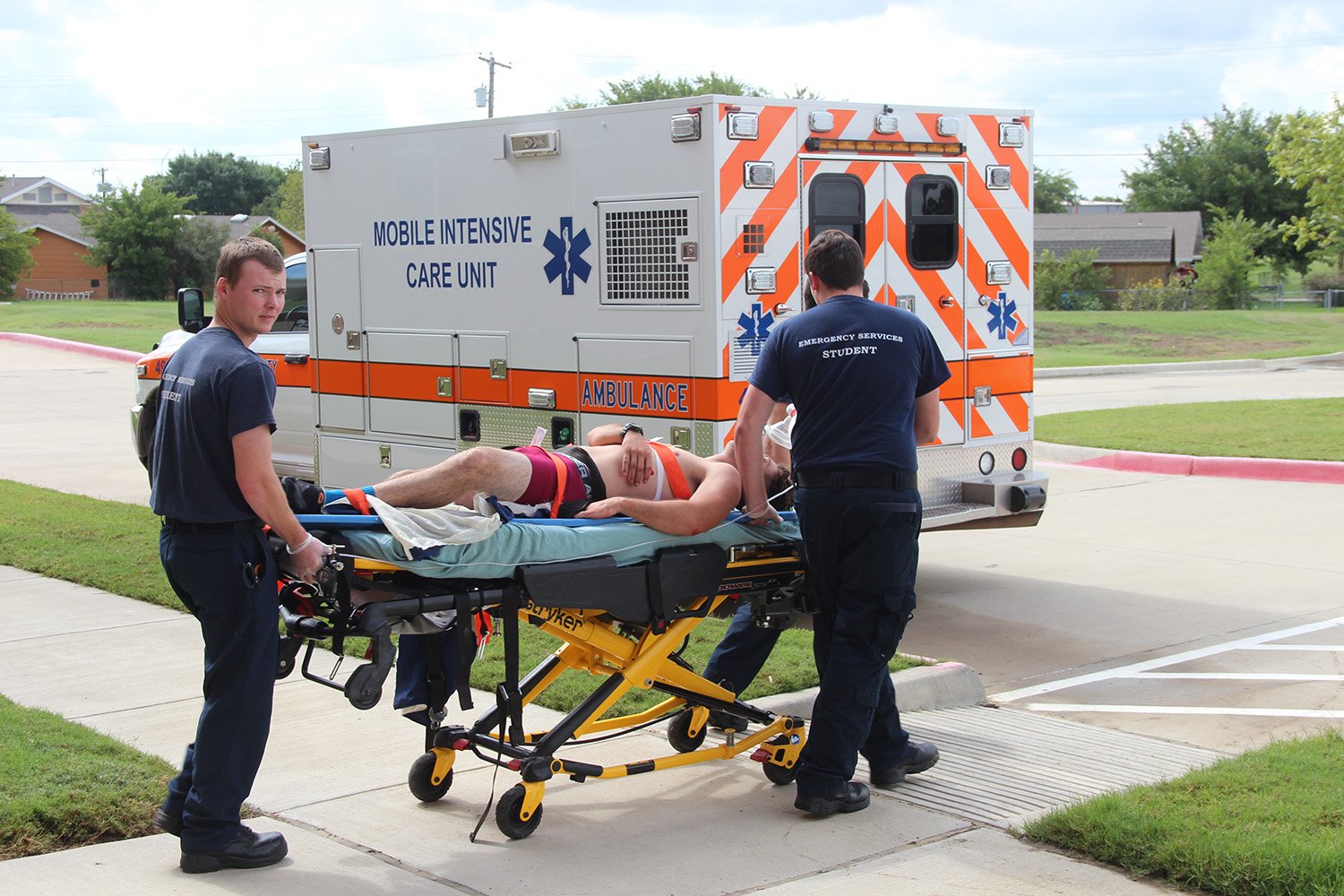
Emergency Medical Services (EMS)
This program is for students wanting to qualify for certification as Emergency Medical Technicians (EMT).
> PROGRAMS > HEALTH SCIENCES > EMERGENCY MEDICAL SERVICES
The Dallas/Ft. Worth Metroplex is one of the fastest growing areas in the nation. With this growth comes the need for more EMS personnel to meet the needs of the public safety. Being an EMS provider is a rewarding profession with the opportunity to make a difference in the community. EMTs and Paramedics respond to emergency calls, performing medical services and transporting patients to medical facilities. Most work full time and their work can be physically strenuous and stressful, sometimes involving life-or-death situations.
The Emergency Medical Technician (EMT) program at NCTC teaches basic life support procedures. EMT is the entry-level certification for EMS. EMTs work alongside Paramedics in the delivery of pre-hospital care. Upon completion of the certificate students will be able to sit for the National Registry examination and apply for the certification through the Texas Department of State Health Services.
Applicants for the Paramedic Program must have Texas DSHS EMT certification. The selection process will be based on the EMT Entrance Exam score. Those who have completed Anatomy & Physiology I & II or VNSG 1420 Anatomy & Physiology course will be given 5 extra points on the exam.
Courses are taught through lecture, case study skills, written assignments, skills demonstrations, and hands-on training. Clinical experiences and Internships are completed through area hospitals and EMS and fire departments.
Our Accreditation
The Paramedic program of North Central Texas College is accredited by the Commission on Accreditation of Allied Health Education Programs (www.caahep.org) upon the recommendation of the Committee on Accreditation of Educational Programs for the Emergency Medical Services Professions (CoAEMSP).
CAAHEP
25400 US Highway 19 N., Suite 158
Clearwater, FL 33763
(727) 210-2350
CoAEMSP
8301 Lakeview Parkway, Suite 111-312
Rowlett, TX 75088
(214) 703-8445
Program Outcomes
2022
National Registry First Time Pass — 84%
National Registry Overall Pass — 92%
Retention — 78%
Placement (graduates who sought jobs or furthered education) — 100%
2021
National Registry First Time Pass — 77%
National Registry Overall Pass — 89%
Retention — 77%
Placement (graduates who sought jobs or furthered education) — 100%
2020
National Registry First Time Pass — 76%
National Registry Overall Pass — 95%
Retention — 81%
Placement (graduates who sought jobs or furthered education) — 100%
Admissions Steps
Step 1: Apply to NCTC.
Step 2: Attend an EMS & Fire Science information session.
Once all admission requirements are met, you will be notified by the Admissions Office of your acceptance to NCTC. You will need to schedule an information session by contacting:
Claudia Leuschner
Emergency Services Administrative Assistant
(940) 498-6237
cleuschner@nctc.edu
Step 3: Register for the HESI Entrance Exam.
HESI testing information will be sent after you sign up for an information session. The candidates that pass the HESI Exam will be invited to the Physical Ability Exam. Once testing is done you can complete and submit an online EMS & Fire Science Application.
Step 4: Apply to the EMS & Fire Science program.
Login to the MyNCTC
Under Student Services, select EMS & Fire Science Application.
Fill out the form and attach copies of your transcripts.
Once you have completed all sections of the application along with your HESI test scores, submit your application.
After applications have been processed, you will be notified by email of your status in the EMS & Fire Science program.
Criteria for enrolling into the EMS programs
Must have a social security number.
Must be at 18 years old.
Must be a high school graduate or have a GED.
Must have medical insurance (can be purchased through agencies that work with NCTC).
Step 5: If accepted to the program, you will need to complete...
Drug Screen
Physical
Physical Agility Exam Waivers
CPR Certification (Healthcare Provider only)

Degrees
You may choose to earn an Emergency Medical Technician-Basic (EMT-B) Certificate or an EMS Certificate or an Associate of Applied Science (AAS) Degree to become a Paramedic. Courses from the Certificate Program will readily transfer to the Degree programs.
Degree Plans
EMT-B Certificate
Offered Fall, Spring, and Summer III semesters, the EMT program teaches basic life support procedures. EMT is the entry-level certification for EMS. EMTs work alongside paramedics in the delivery of pre-hospital care. Successful completion of this program entitles the student to sit for the National Registry examination and apply for the certification through the Texas Department of State Health Services. Upon completion of the certificate, you will be able to:
Describe the scope of EMT-Basic practice within local, state, and national parameters.
Demonstrate the desirable qualities of an EMS provider that contribute to high professional and ethical standards.
Recognize, assess and manage medical and traumatic emergencies while establishing priorities under the appropriate medical control. Procedures will include physical assessment, extrication, basic life support, airway control and ventilation, psychological support, and other forms of basic life support.
Coordinate scene management, patient care, and transportation with other agencies.
Establish rapport with first responders, agencies, patient's family members, and staff of receiving hospitals.
Concisely document through written and oral communications, events relative to the provision of emergency care.
In the event of contingencies, exercise personal judgment that is sound and appropriate for the situation.
Courses and credit hours () required to earn the EMT-B Certificate.
First Semester
EMSP 1501 EMERGENCY MEDICAL TECHNICIAN — (5)
EMSP 1160 CLINICAL - EMERGENCY MEDICAL TECHNICIAN/TECHNOLOGY — (1)
Total credit hours — (6)
EMS Certificate — Paramedic
The Paramedic program teaches basic and advanced life support. Certified paramedics are the primary care providers in advanced level ambulances and fire departments. Courses are taught through lecture, case study skills, written assignments, skills demonstrations, and hands-on training. Clinical experiences and Internships are completed through area hospitals and EMS/fire departments. The Paramedic Certificate program is designed to take one year to complete. Following successful completion of the program, tyou will be able to:
Describe the scope of paramedic practice within local, state and national parameters.
Demonstrate the desirable qualities of an EMS provider that contribute to high professional and ethical standards.
Recognize, assess and manage medical and traumatic emergencies while establishing priorities under the appropriate medical control. Procedures will include physical assessment, extrication, basic life support, airway control and ventilation, fluid resuscitation, drug therapy, emergency delivery, cardiac monitoring and electrical intervention, psychological support and other forms of basic and advanced life support.
Coordinate scene management, patient care, and transportation with other agencies.
Establish rapport with first responders, agencies, patient's family members, and staff of receiving hospitals.
Concisely document through written and oral communications, events relative to the provision of emergency care.
In the event of contingencies, exercise personal judgment that is sound and appropriate for the situation.
Courses and credit hours () required to earn the EMS Certificate.
Total credit hours — (39)
EMS AAS — Paramedic
The Paramedic program teaches basic and advanced life support. Certified paramedics are the primary care providers in advanced-level ambulances and fire departments. The AAS degree has the EMS courses but also includes academic courses, so you may pursue your Paramedic Licensure and AAS Degree in Paramedicine. Licensure through the Department of State Health and Human Services of Texas requires Licensed Paramedics to have a degree. Courses are taught through lectures, case study skills, written assignments, skills demonstrations, and hands-on training. Clinical experiences and Internships are completed through area hospitals and EMS/fire departments. The Paramedicine degree is designed to take two years to complete. Upon completion, you will be able to:
Describe the scope of paramedic practice within local, state, and national parameters.
Demonstrate the desirable qualities of an EMS provider that contribute to high professional and ethical standards.
Recognize, assess and manage medical and traumatic emergencies while establishing priorities under the appropriate medical control. Procedures will include physical assessment, extrication, basic life support, airway control and ventilation, fluid resuscitation, drug therapy, emergency delivery, cardiac monitoring and electrical intervention, psychological support, and other forms of basic and advanced life support.
Coordinate scene management, patient care, and transportation with other agencies.
Establish rapport with first responders, agencies, patient's family members, and staff of receiving hospitals.
Concisely document through written and oral communications, events relative to the provision of emergency care.
In the event of contingencies, exercise personal judgment that is sound and appropriate for the situation.
Courses and credit hours () required to earn the EMS AAS.
Third Semester
CORE HUMANITIES OR FINE ARTS ELECTIVE — (3)
EMSP 2262 CLINICAL II-EMERGENCY MEDICAL TECHNICIAN/PARAMEDIC — (2)
EMSP 2434 MEDICAL EMERGENCIES — (4)
EMSP 1355 TRAUMA MANAGEMENT — (3)
EMSP 2237 EMERGENCY PROCEDURES — (2)
EMSP 1356 PATIENT ASSESSMENT AND AIRWAY MANAGEMENT — (3)
Total credit hours for this semester — (17)
Fourth Semester
MATH 1314 COLLEGE ALGEBRA or MATH 1324 MATHEMATICS FOR BUSINESS & SOCIAL SCIENCES or MATH 1332 CONTEMPORARY MATHEMATICS or MATH 1342 ELEMENTARY STATISTICAL METHODS — (3)
SPCH 1311 INTRODUCTION TO SPEECH COMMUNICATION or SPCH 1315 PUBLIC SPEAKING — (3)
EMSP 2364 PRACTICUM - EMERGENCY MEDICAL TECHNOLOGY/TECHNICIAN EMT/PARAMEDIC* — (3)
EMSP 2243 ASSESSMENT BASED MANAGEMENT — (2)
EMSP 2305 EMS OPERATIONS — (3)
Total credit hours for this semester — (14)
* EMSP 2364: Capstone Experience
Total credit hours — (60)
Job Outlook
$17.76/hour
Median Pay
No 4-year Degree Needed
11%
Job Growth 2020-2030
261,300
Job Openings
Places of Employment
Private/Municipal/State/Federal Fire Suppression, EMS, or Public Safety Organizations
Industrial Contractors
Hospitals/Healthcare Facilities
Athletic Organizations
Law Enforcement
Jobs
Paramedic
Firefighter/Paramedic
Community Paramedic
Industrial Paramedic
Emergency Department Technician
Critical Care Paramedic
Patient Transport Paramedic
Flight Paramedic
Sports Medicine Trainer
Tactical Paramedic

Contact us.
Claudia Leuschner
Emergency Services Administrative Assistant
(940) 498-6237
cleuschner@nctc.edu



